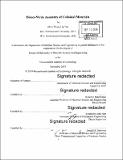Direct-write assembly of colloidal materials
Author(s)
Tan, Alvin Thong Lip.
Download1135981025-MIT.pdf (13.77Mb)
Other Contributors
Massachusetts Institute of Technology. Department of Materials Science and Engineering.
Advisor
A. John Hart.
Terms of use
Metadata
Show full item recordAbstract
Colloidal assembly, which is the spontaneous organization of nano- and micro- sized particles, is an attractive means to create materials with properties that can be engineered via hierarchy of particle composition, size, ordering, and macroscopic form. However, while there are well-established methods for assembling colloidal crystals as films and patterns on substrates, it has not been previously possible to build freeform colloidal crystal structures. Macroscale, freeform colloidal crystals could enable the development of novel composites, photonics, electronics, and new studies of crystallization in three-dimensions. This thesis describes the development of direct-write assembly, a process combining the bottom-up principle of colloidal self-assembly with the versatility of direct-write 3-D printing. Direct-write assembly is performed by precision dispense of a colloidal suspension from a fine needle into a temperature-controlled environment. Using polystyrene particles suspended in water as a model system, we derive a scaling law that governs the rate of assembly. Moreover, by high resolution motion control of the substrate, the trajectory of crystal growth, and therefore the shape of the crystal, can be controlled in freeform. We show how to prevent cracking in these free-standing colloidal crystals, and demonstrate the emergence of structural color tunable by particle size. We also explore in-plane direct-write as a means for fabricating colloidal crystals patterned by a digital template. The kinetics of crystal growth can be modelled by the Dimitrov-Nagayama equation for convective assembly, which allows us to develop an operational phase diagram to serve as a practical guide for high-throughput assembly. Moreover, we develop a means of rapidly characterizing grain structure from the optical diffractive properties of the colloidal crystal. By sequentially sintering and overlapping passes, in-plane direct-write can potentially build up to 3-D structures. Finally, we consider the scaling of forces in the direct-write assembly process and demonstrate that direct-write can be extended to various particle systems. In particular, we demonstrate application of direct-write to the assembly of colloidal silica, gold, and iron oxide supercrystals.
Description
Thesis: Ph. D., Massachusetts Institute of Technology, Department of Materials Science and Engineering, 2019 Cataloged from PDF version of thesis. Includes bibliographical references (pages 102-108).
Date issued
2019Department
Massachusetts Institute of Technology. Department of Materials Science and EngineeringPublisher
Massachusetts Institute of Technology
Keywords
Materials Science and Engineering.